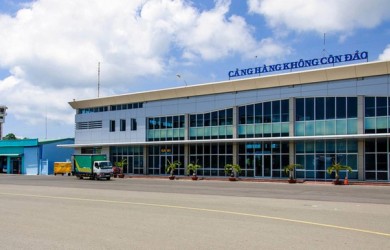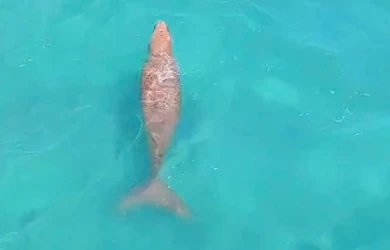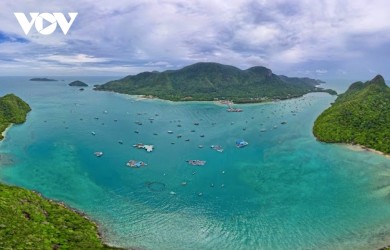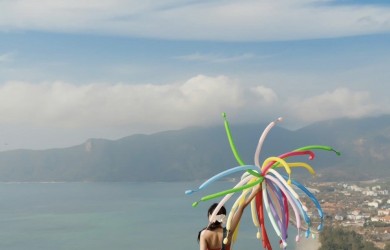“Keeping the blue of the sea”: “Be in labour” with Con Dao sea turtles
Con Dao has become an attractive tourist destination, attract more and more domestic and foreign tourists. Coming here, in addition to learning about the great revolutionary historical values preserved on this land, visitors also have the opportunity to visit and discover the values of biodiversity.
In particular, Bay Canh islet, a beautiful island is known as the most ecological island in Con Dao with primeval forests, mangroves belonging to the island's tropical ecosystem and 882 species of plants, nearly 150 species of animals. Especially, visitors will come to the large sand beach located at the foot of the Lighthouse, one of the 14 spawning grounds of sea turtles and the beach with a large number of turtles laying eggs in Con Dao to be in labour with turtles.
As noted by scientists, the beaches of Bay Canh islet are the places where the largest number of sea turtles come to nest and lay eggs in Vietnam. Mr. Nguyen Dinh Ly - Chief of Bay Canh Forest Protection Station said: "As rangers working in the island district, we always uphold the sense of responsibility for the work of forest guarding and protecting the homeland's sea and islands. Especially, being able to do sea turtle conservation by doing meaningful things such as being a "midwife" for mother turtles, we feel happy and always try to introduce to many tourists, spread the meaning of hygiene ecology, environment and conservation of rare sea turtles."
Being in labour with turtles
When the water is high, the image of the mother turtle begins to flicker on the sea waves near the shore to find a place to lay eggs. This is also the time when the ranger announces that you are allowed to go to the turtle spawning area.
When watching the mother turtle lay eggs, people absolutely must not use flashlights, phone lights, but can only use specialized lights of the rangers. In particular, do not stand in front of the turtle's head and do not make noise.
In the silver moonlight, visitors will see the mother turtle slowly crawling ashore. They choose an area of fine sand near the groves and then use their front legs to dig a nest, then use their hind legs to dig a hole about 50-60cm deep, about 20cm wide and start laying eggs. In the soft light, each round and white turtle egg like a ping-pong ball, into the nest. When the job is done, the mother turtle uses her feet to cover the nest, erase the traces and disguise her egg nest.
Waiting for the mother turtle to leave the nest, forest rangers will perform a step in the conservation of sea turtles, which is to take the eggs back to the nest. Eggs are incubated for 6 hours. When bringing back, half of the eggs will be put in a place with much light, while the other half will be put into the hatching pond covered against a sun. This is to balance the "sex" for the baby turtles hatching, because sea turtles can adjust the male - female thanks to the impact of light and temperature in incubating period. About 45 - 60 days after being brought to the incubator, the eggs will hatch.
While visiting the incubation, you may see baby turtles incubated from the time before hatching. You will see each turtle trying to get out of the egg shell and climb up to the mouth of the nest to crawl towards the sea. The ranger will put the baby turtles in a basket and bring them down to the sandy shore when the water is high and the sun is not too hot, because the light shining into the eyes will make the baby turtles lose their way.
Hundreds and thousands of baby turtles crawl into the sea on their own for a distance of several tens of meters. Before the baby turtles enter the sea, they still have time to turn their heads to record images of where they were born, so that when they become adults (about 30 years later), the sea turtles will return to the place where they were born to lay their eggs.
Cao Duc Cuong - Ranger of Con Dao National Park Management Board said “Bay Canh is one of 16 small islands in Con Dao National Park with an area of 693 hectares, located to the east of Con Son main island. Bay Canh consists of two islands connected by a sandbar in the middle called Cat Lon b. This place is the largest spawning ground and has the highest number of mother turtles laying eggs in Vietnam. To do well in the conservation of sea turtles, the important step is to "help to give birth" to the turtles, sometimes we stay up all night to watch the turtles on the beach, monitor, support and move the eggs to the incubation. A mother turtle successfully crosses the water, turns her head back to the sea, we feel happy and relieved, so whether we stay up all night or have a hard time, we are always proud of our contribution to protecting natural sea turtle conservation. Recommend to visitors we are more than happy; guide visitors because the biological nature of the species is very sensitive to noise and light, all activities must take place in silence and remind visitors while turtles are laying, do not shine lights into turtle eyes and stand on the head of the turtle."
Spread the meaning
Due to the characteristics, turtles often come ashore according to the tide, so if you want to see turtles laying, you have to stay up all night, that is what helps visitors to understand somewhat the hardships of the authorities at the beach there in the rescue and conservation of sea turtles. Many tourists, after witnessing the mother turtle performing her sacred duty and the forest rangers help the turtle give birth fully, also voluntarily participate in moving the eggs to the incubation, with an appointment to return 60 days later on the occasion of the eggs hatch to welcome the baby turtles.
Mr. Nguyen Van Ngoc - a tourist from Ho Chi Minh City said: “I am very excited to experience the tour to see turtles lay eggs. No matter how many journeys I have to go through, to Con Dao, and I move to a small island, but my trip is meaningful and interesting. I will definitely come back to Con Dao, experience watching turtles lay eggs and release baby turtles to the sea; propagate to people about environmental protection, forest and marine ecosystems, and sea turtle conservation in Con Dao.
Con Dao National Park has about 18 beaches where turtles lay eggs. In which, 5 beaches with large area and the highest number of mother turtles giving birth such as Bay Canh islet, Duong beach, Cau islet, Tre Lon islet, Tai islet are arranged with ranger stations to protect natural resources and conservation of sea turtles.
Every year, from April to November, about 400 mother turtles come to the beach to lay over 1,000 egg nests. Mainly the 2 globally endangered sea turtle species are the chelone and hawksbill. Through practice and surveys, many scientists and international experts in the field of marine biology and nature conservation have also rated Con Dao as the most successful place to protect and incubate turtle eggs. Every year, the number of mother turtles goes to the sandbanks to lay eggs about 2,000 times, and the vast ocean receives another 120,000 to 150,000 baby turtles.
Saying goodbye to Bay Canh islet is also when the sun rises, signaling the beginning of a new day in a remote island. It is the end the exciting tour with memorable experiences. Surely, anyone who comes to Bay Canh will always remember an island because the natural environment here is preserved almost intact thanks to the ecotourism development planning associated with the task of preserving natural resources and biodiversity. And more specifically, the feelings about the experience of watching the mother turtle lay eggs, being introduced to the conservation of sea turtles in the beautiful and sacred land of Con Dao will forever remain in the hearts of every visitor.
As noted by scientists, the beaches of Bay Canh islet are the places where the largest number of sea turtles come to nest and lay eggs in Vietnam. Mr. Nguyen Dinh Ly - Chief of Bay Canh Forest Protection Station said: "As rangers working in the island district, we always uphold the sense of responsibility for the work of forest guarding and protecting the homeland's sea and islands. Especially, being able to do sea turtle conservation by doing meaningful things such as being a "midwife" for mother turtles, we feel happy and always try to introduce to many tourists, spread the meaning of hygiene ecology, environment and conservation of rare sea turtles."

Being in labour with turtles
When the water is high, the image of the mother turtle begins to flicker on the sea waves near the shore to find a place to lay eggs. This is also the time when the ranger announces that you are allowed to go to the turtle spawning area.

When watching the mother turtle lay eggs, people absolutely must not use flashlights, phone lights, but can only use specialized lights of the rangers. In particular, do not stand in front of the turtle's head and do not make noise.
In the silver moonlight, visitors will see the mother turtle slowly crawling ashore. They choose an area of fine sand near the groves and then use their front legs to dig a nest, then use their hind legs to dig a hole about 50-60cm deep, about 20cm wide and start laying eggs. In the soft light, each round and white turtle egg like a ping-pong ball, into the nest. When the job is done, the mother turtle uses her feet to cover the nest, erase the traces and disguise her egg nest.
Waiting for the mother turtle to leave the nest, forest rangers will perform a step in the conservation of sea turtles, which is to take the eggs back to the nest. Eggs are incubated for 6 hours. When bringing back, half of the eggs will be put in a place with much light, while the other half will be put into the hatching pond covered against a sun. This is to balance the "sex" for the baby turtles hatching, because sea turtles can adjust the male - female thanks to the impact of light and temperature in incubating period. About 45 - 60 days after being brought to the incubator, the eggs will hatch.
While visiting the incubation, you may see baby turtles incubated from the time before hatching. You will see each turtle trying to get out of the egg shell and climb up to the mouth of the nest to crawl towards the sea. The ranger will put the baby turtles in a basket and bring them down to the sandy shore when the water is high and the sun is not too hot, because the light shining into the eyes will make the baby turtles lose their way.
Hundreds and thousands of baby turtles crawl into the sea on their own for a distance of several tens of meters. Before the baby turtles enter the sea, they still have time to turn their heads to record images of where they were born, so that when they become adults (about 30 years later), the sea turtles will return to the place where they were born to lay their eggs.
Cao Duc Cuong - Ranger of Con Dao National Park Management Board said “Bay Canh is one of 16 small islands in Con Dao National Park with an area of 693 hectares, located to the east of Con Son main island. Bay Canh consists of two islands connected by a sandbar in the middle called Cat Lon b. This place is the largest spawning ground and has the highest number of mother turtles laying eggs in Vietnam. To do well in the conservation of sea turtles, the important step is to "help to give birth" to the turtles, sometimes we stay up all night to watch the turtles on the beach, monitor, support and move the eggs to the incubation. A mother turtle successfully crosses the water, turns her head back to the sea, we feel happy and relieved, so whether we stay up all night or have a hard time, we are always proud of our contribution to protecting natural sea turtle conservation. Recommend to visitors we are more than happy; guide visitors because the biological nature of the species is very sensitive to noise and light, all activities must take place in silence and remind visitors while turtles are laying, do not shine lights into turtle eyes and stand on the head of the turtle."
Spread the meaning
Due to the characteristics, turtles often come ashore according to the tide, so if you want to see turtles laying, you have to stay up all night, that is what helps visitors to understand somewhat the hardships of the authorities at the beach there in the rescue and conservation of sea turtles. Many tourists, after witnessing the mother turtle performing her sacred duty and the forest rangers help the turtle give birth fully, also voluntarily participate in moving the eggs to the incubation, with an appointment to return 60 days later on the occasion of the eggs hatch to welcome the baby turtles.

Mr. Nguyen Van Ngoc - a tourist from Ho Chi Minh City said: “I am very excited to experience the tour to see turtles lay eggs. No matter how many journeys I have to go through, to Con Dao, and I move to a small island, but my trip is meaningful and interesting. I will definitely come back to Con Dao, experience watching turtles lay eggs and release baby turtles to the sea; propagate to people about environmental protection, forest and marine ecosystems, and sea turtle conservation in Con Dao.
Con Dao National Park has about 18 beaches where turtles lay eggs. In which, 5 beaches with large area and the highest number of mother turtles giving birth such as Bay Canh islet, Duong beach, Cau islet, Tre Lon islet, Tai islet are arranged with ranger stations to protect natural resources and conservation of sea turtles.
Every year, from April to November, about 400 mother turtles come to the beach to lay over 1,000 egg nests. Mainly the 2 globally endangered sea turtle species are the chelone and hawksbill. Through practice and surveys, many scientists and international experts in the field of marine biology and nature conservation have also rated Con Dao as the most successful place to protect and incubate turtle eggs. Every year, the number of mother turtles goes to the sandbanks to lay eggs about 2,000 times, and the vast ocean receives another 120,000 to 150,000 baby turtles.
Saying goodbye to Bay Canh islet is also when the sun rises, signaling the beginning of a new day in a remote island. It is the end the exciting tour with memorable experiences. Surely, anyone who comes to Bay Canh will always remember an island because the natural environment here is preserved almost intact thanks to the ecotourism development planning associated with the task of preserving natural resources and biodiversity. And more specifically, the feelings about the experience of watching the mother turtle lay eggs, being introduced to the conservation of sea turtles in the beautiful and sacred land of Con Dao will forever remain in the hearts of every visitor.
Source: baotainguyenmoitruong/ Translator: My Phuong
Newer articles
Older articles

















